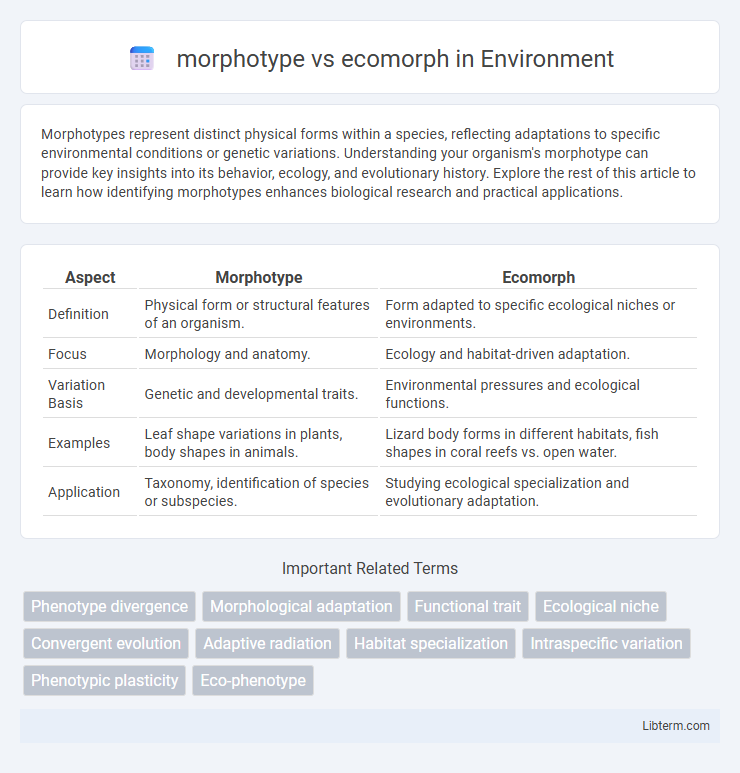Morphotypes represent distinct physical forms within a species, reflecting adaptations to specific environmental conditions or genetic variations. Understanding your organism's morphotype can provide key insights into its behavior, ecology, and evolutionary history. Explore the rest of this article to learn how identifying morphotypes enhances biological research and practical applications.
Table of Comparison
| Aspect | Morphotype | Ecomorph |
|---|---|---|
| Definition | Physical form or structural features of an organism. | Form adapted to specific ecological niches or environments. |
| Focus | Morphology and anatomy. | Ecology and habitat-driven adaptation. |
| Variation Basis | Genetic and developmental traits. | Environmental pressures and ecological functions. |
| Examples | Leaf shape variations in plants, body shapes in animals. | Lizard body forms in different habitats, fish shapes in coral reefs vs. open water. |
| Application | Taxonomy, identification of species or subspecies. | Studying ecological specialization and evolutionary adaptation. |
Defining Morphotype and Ecomorph
Morphotype refers to the distinct physical form or structural features of an organism categorized based on morphology, often independent of ecological function. Ecomorph describes a group of organisms that share similar morphological traits specifically adapted to their ecological niche or environment. Defining morphotype emphasizes anatomical characteristics, while defining ecomorph focuses on the relationship between form and ecological roles.
Origins and Usage of the Terms
Morphotype and ecomorph originate from distinct biological disciplines, with morphotype first coined in taxonomy to classify organisms based on morphological traits, while ecomorph emerged in ecology to describe species adapted to specific environmental niches. Morphotype emphasizes structural form variations independent of ecological function, whereas ecomorph highlights adaptive traits linked to ecological roles and habitat utilization. Both terms are essential for understanding phenotypic diversity, with morphotype often applied in paleontology and systematics, and ecomorph prominently used in evolutionary biology and ecological studies.
Morphotype: Key Characteristics
Morphotype refers to a distinct set of physical traits and structural features that define an organism's form, often linked to genetic factors and evolutionary adaptations. Key characteristics of a morphotype include consistent body shape, size, and morphological adaptations that influence an organism's functionality and ecological interactions. Morphotypes provide critical insight into biodiversity, species identification, and evolutionary biology by highlighting morphological variations within and across populations.
Ecomorph: Key Characteristics
Ecomorphs are defined by specific ecological roles and adaptations allowing species to exploit distinct environmental niches, such as arboreal, terrestrial, or saxicolous habitats. Key characteristics of ecomorphs include morphological traits tailored for particular functions, like limb length for climbing or body shape for burrowing, which enhance survival and reproduction in their specific habitats. These adaptations result from convergent evolution, where unrelated species develop similar features in response to comparable environmental pressures.
Morphotype vs Ecomorph: Core Differences
Morphotype refers to the physical form or structural features of an organism, emphasizing its morphological adaptations, while ecomorph describes the correlation between an organism's morphology and its ecological niche or habitat. Morphotypes are classified based on anatomical traits such as limb length or body shape, whereas ecomorphs illustrate how these traits enable survival and functionality within specific environmental contexts. Understanding the core differences between morphotype and ecomorph clarifies the distinction between form (morphology) and function (ecology) in evolutionary biology.
Ecological and Evolutionary Implications
Morphotype variations represent distinct physical forms within a species influenced primarily by genetic factors, while ecomorphs are morphotypes shaped predominantly by ecological pressures and environmental adaptations. The differentiation of ecomorphs highlights adaptive radiation and ecological niche specialization, driving evolutionary divergence within populations. Understanding this interplay between morphotypes and ecomorphs elucidates mechanisms of natural selection, habitat-driven speciation, and biodiversity patterns in evolutionary biology.
Examples of Morphotypes in Nature
Morphotypes represent distinct physical forms within a species shaped by genetic factors, exemplified by the various beak shapes of Darwin's finches adapted to different food sources. Ecomorphs, on the other hand, are forms within species that arise due to environmental pressures, such as Anolis lizards displaying different limb lengths and toepad sizes corresponding to their arboreal or terrestrial habitats. Notable morphotype examples include the coat color variations in rock pocket mice, which correlate with substrate color to provide camouflage and enhance survival.
Examples of Ecomorphs in Nature
Ecomorphs are organisms with specific morphological adaptations that enable them to thrive in particular ecological niches, such as Anolis lizards displaying distinct limb lengths adapted for different microhabitats like tree trunks, twigs, and ground surfaces. Morphotypes, in contrast, refer to variations in physical form without direct emphasis on ecological function. Examples of ecomorphs include Darwin's finches, which show beak shape variations correlating to specific dietary sources, and cichlid fish demonstrating jaw differences related to feeding strategies within African lakes.
Importance in Biodiversity Studies
Morphotypes represent distinct physical forms within a species, while ecomorphs are variations shaped by ecological roles and habitats. Understanding morphotype and ecomorph diversity is critical in biodiversity studies for identifying adaptive traits that promote species survival and ecosystem resilience. This differentiation aids in tracking evolutionary processes and assessing environmental impacts on population structure.
Impacts on Conservation and Taxonomy
Morphotype classification, based on observable physical traits, often overlooks ecological roles, leading to potential misidentifications in taxonomy. Ecomorph categorization emphasizes adaptive traits linked to specific environments, providing critical insights for conservation strategies by highlighting niche diversity and ecosystem function. Integrating both approaches enhances species delimitation accuracy and informs targeted habitat preservation efforts, ultimately improving biodiversity management.
morphotype Infographic

 libterm.com
libterm.com